We will disseminate information on herbs and aromas.
Dr. Akiko
Moved to Shonan from central Tokyo due to the new coronavirus disaster.
After researching and developing pharmaceuticals, I am currently a lecturer in herbs and aromas.
I will deliver the health benefits of herbs and aromas, how to use them, and the growth record of herbs during cultivation.
Is cola a health beverage?
Coca-Cola was first developed by Dr. Pemberton and was marketed in 1885 as "French Wine Coca", which is a blend of cocaine and cola extracts in wine, as a medicinal liquor that is effective in boosting energy and relieving headaches, but eventually cocaine addiction became a problem, and instead of wine, "Coca-Cola" was used as a syrup to flavor carbonated water. It was launched in 1886. Today, cola is positioned as a soft drink, but when it was first developed, it was a health beverage.
- Cola Tree, Cola nitida Sterculiaceae
- Cola tree contains caffeine in the seeds (cola nuts).
Fatigue relieving effect.
Although this plant is not used in current cola, many cola drinks contain caffeine. - Coca Tree, Erythroxylon coca Erythroxylaceae
- Coca tree contains cocaine in the leaves.
Local anesthetic effect.
It is designated as a narcotic because it is highly toxic and addictive.
Of course, it is not used in the current cola.
Recently, craft cola (handmade cola) has become popular, and many products that reproduce the taste of cola using spices and herbs are now on sale, and there are many products that are sold exclusively as local cola. In addition, there are many recipes that make it easy to make cola syrup at home on the website.
Some of the spices that are almost always used in craft cola include:
- Clove, Syzygium aromaticum Myrtaceae
- Herbal medicine name in Japan: Choji
Main ingredient: Eugenol
Function: Antibacterial, analgesia, local anesthetic - Cardamom Elettariaa cardamum Zingiberaceae
- Herbal medicine name in Japan: Shozuku
Function: Digestive function promotion, analgesic, antispasmodic - Cinnamon, Cinnamomum verum, Cinmamomum cassia Lauraceae
- Herbal medicine name in Japan: Keihi
The main ingredient: Cinnamaldehyde
Function: Digestive function promotion, antibacterial - Ginger Zinguber officinale Zingiberaceae
- Herbal medicine name: Shokyo, Kankyo
Key Ingredients: Gingerol, Shogaol
Function: Digestive function promotion, anti-inflammatory, analgesic
All these spices are also used in herbal medicine, and contain essential oil components (aromatic components), improve digestive function, increase appetite, and prevent food poisoning by antibacterial action. Cola is a drink that is often drunk in the summer, but cola handmade with these spices can be an effective drink when your appetite is low or your digestive system is weakened due to summer heat. In addition, handmade cola made without the cola tree (cola nut) is caffeine-free, so it is recommended for those who do not like caffeine. In addition to the above, you can also add spices such as nutmeg, black pepper, coriander seeds, cayenne pepper, star anise, and anise seeds if you like. It's also fun to add citrus fruits and your favorite things such as lime and orange to make your own cola.
How to make Kraft Cola
- 【Basic Materials】
- ● Water
- 200ml
- ● Sugar
- 100g
- ● Clove
- 20 pcs
- ● Cardamom
- 10 pcs (Crush with scissors or mortar)
- ● Cinnamon Sticks
- 2 pcs (Tear it into pieces of about 3 cm)
- ● Vanilla bean*1
- 1/2 scabbard (Open the scabbard and scrape the
contents, use both the scabbard and the contents) - ● Lemon*2 (peel, juice)
- 1 pc (Squeeze the juice and cut the rest into thin slices)
- ● Ginger
- 1 piece(thinly sliced)
*1 Can be substituted with vanilla extract
*2 Because it uses leather, it does not use anti-mold materials.
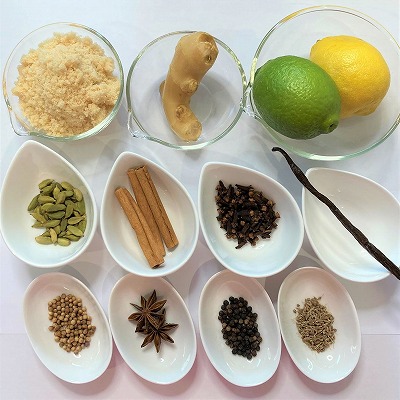
- 【How to make】
- Put the materials except lemon juice in a saucepan and put it on the fire, and when it boils, simmer on low heat for 10 minutes.
- When the heat is removed, add the lemon juice, transfer to a clean container and soak in the refrigerator overnight.
- Filter with a tea strainer and transfer to a clean storage container (syrup can be stored in the refrigerator for about 2 weeks)
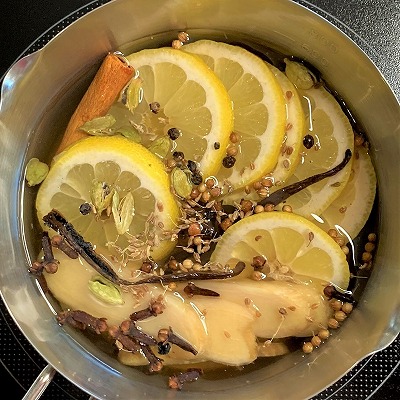
- Divide the syrup with carbonated water.
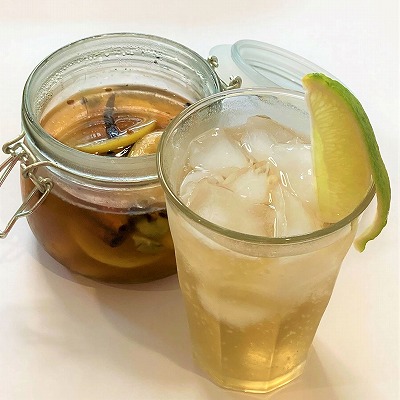
The scent of herbs as an insect repellent
In order to avoid being eaten by insects, plants produce scents (essential oil components) that insects dislike. Therefore, you can use essential oils to make insect repellent sprays and insect repellent candles, or plant herbs that have an insect repellent effect in your garden or balcony to prevent insects from entering.
Herbs that are well known for their insect repellent properties include lemongrass, lemon eucalyptus, and geranium. What ingredients do these herbs contain?
Citral* (geranial + neral) contained in lemongrass and citronellal contained in lemon eucalyptus are well-known ingredients that have an insect repellent effect. In terms of chemical structure, all of them belong to the terpene aldehyde class and have a strong scent like lemon.
There is an essential oil component called citronellol contained in geranium with a similar name, but this is also an ingredient that has a high insect repellent effect, and in terms of chemical structure, the aldehyde part of citronellal is replaced by alcohol. The scent is milder and sweeter than the aforementioned citral and citronellal. Geranium essential oil as a whole has a gorgeous floral scent that is very similar to rose otto essential oil.
If you don't like the scent of so-called herbal insect repellent, you probably have an image of the strong scent of citral and citronellal, but the scent of geranium, which contains citronellol, is a gentle scent while having an insect repellent effect, so please try it once.
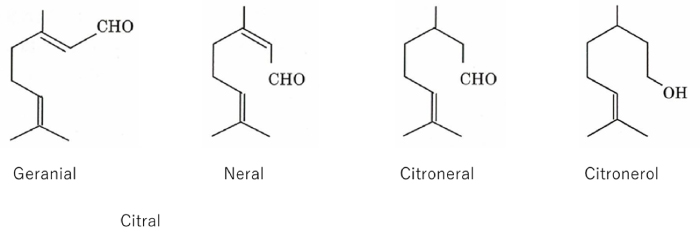
∗Citral: Geranial (trans) and neral (cis) are geometric isomers that are usually mixed, and together they are called citral. It is not an ingredient called citral.
- Lemon Grass, Cymbopogon citratus Poaceae
- Main ingredients: Citral (geranial 40~50%, neral 30~50%)
Efficacy: calming, anti-inflammatory, insects avoided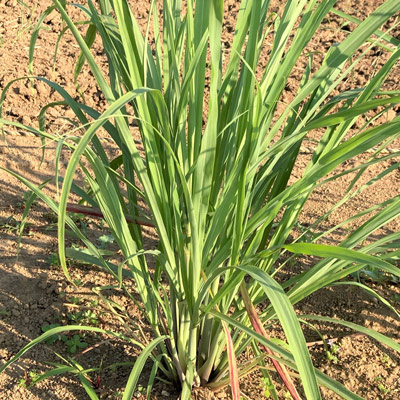
It is a lemongrass growing in the field
It likes high temperatures and humidity, so it is growing from a small seedling in 2 months
Even if you plant it in the field, there are almost no insects on it - Lemon Eucalyptus, Eucalyptus citriodora Myrtaceae
- Main ingredient: Citronellal (70~85%)
Efficacy: anti-inflammatory, analgesia, sedation, insect avoidance - Geranium, Pelargonium graveolens Geraniaceae
- Main ingredients: citronerol (25~40%), geraniol, linalool
Efficacy: astringent, antibacterial, insect repellent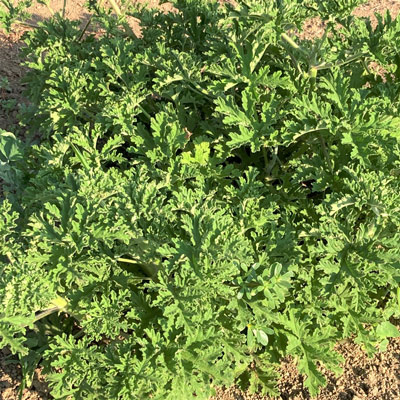
It is a geranium growing in the field
It blooms in spring with small pink flowers
There are many cultivated varieties of geraniums, so check the scientific name and buy it
There is a sweet scent in the air, and there are no insects at all
Measures against hay fever with herbs and aromas
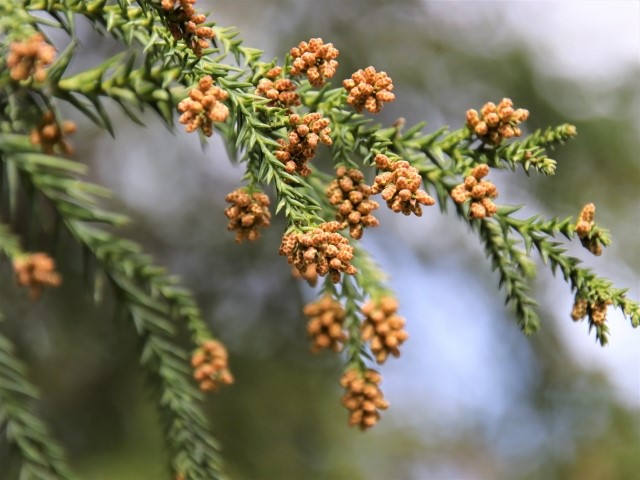
Male cedar flowers with plenty of pollen
In Germany, nettle and elderflower are often used as spring remedies to combat allergies in spring. Both have a diuretic effect and are used to improve allergies because they have a high detoxifying effect. In addition, by excreting excess water, it relieves catarrhal symptoms such as nasal congestion. You can also blend herbs with a refreshing scent, such as peppermint, or rosehips for vitamin C supplementation.
- Elderflower, Sumbucus nigra
Lempsaceae, Flower - Ingredients: flavonoid glycosides (rutin, quercitrin), minerals
Indications: cold, diuretic, anti-allergic - Nettle, Urtica dioica
Urticaceae, Leaf - Ingredients: flavonoids (quercetin), flavonoid glycosides (rutin), minerals
Indications: allergic diseases such as hay fever and atopy, gout, rheumatism

Koalas and eucalyptus
As a countermeasure against hay fever using essential oils, we recommend eucalyptus radiata and rosemary cineol, which contain a lot of 1,8-cineole, which is a soothing scent component. It has immunomodulatory, anti-catarrhal, and expectorant effects, and is very effective in relieving the symptoms of hay fever. If you mix it with a gel or cream base and apply it to the chest area, it will improve the passage of the nose and make breathing easier. These essential oils are also recommended for masks, sprays, etc.
- Eucalyptus Eucaryptus radiata
Myrtaceae, Leaves - Ingredients: 1,8-Cineole, α-Terpineol, Limonene
Indications: hay fever, colds - Rosemary, Rosmarinus officinalis CT (Cineole)
Lamiaceae, Flowers and Stems and leaves - Ingredients: 1,8-cineole, α-pinene, camphor
Indications: hay fever, colds
Conquering hay fever with the scent of the forest?
Among the essential oils for the prevention of hay fever, the essential oil of Todo pine (fir) has recently attracted attention, and it has been reported that the effect is particularly high on Hokkaido fir.
The essential oil of fir contains a component called β-phellandrene, which has been shown to have the effect of removing nitrogen dioxide. Since pollen binds to nitrogen dioxide contained in polluted air and increases its antigenicity, purifying the air with β-phellandrene is expected to lead to the prevention of hay fever. It is also recommended to incorporate the scent of fir to purify the air.
Beware of phototoxicity

Electromagnetic waves with a wavelength of 200-400 nm among the sun's rays are called ultraviolet rays (near-ultraviolet rays)
There is a "phototoxicity test" as a toxicity test at the research and development stage of pharmaceuticals. Phototoxicity is a type of toxicity in which a compound is activated under ultraviolet radiation to cause an inflammatory response or pigmentation in the skin. There are many medicines that cause phototoxicity, but especially ketoprofen, which is often used as a poultice, is phototoxic, so care must be taken not to expose skin to sunlight when using it as a poultice or ointment, or for several hours after peeling off. Be especially careful in spring and summer, when ultraviolet rays become stronger.
Some medical herbs and aromas also contain phototoxic ingredients.
In medical herbs, the components of St. John's wort, which is often used to improve mild to moderate depressive symptoms, have a phototoxic effect. Hypericin, a red pigment, is oil-soluble and has anti-inflammatory and analgesic properties, so St. John's wort infused oil may be used topically to reduce inflammation. It is OK if you drink herbal tea with the expectation of antidepressant effects, but you need to be careful about phototoxicity when applying infused oil to the skin.
- St. John's wort, Hypericum perforatum
Hypericaceae, aboveground part at the time of flowering - Ingredients: hypericin, hyperforin, tannins, flavonoid glycosides
Indications: mild to moderate depression, premenstrual syndrome (PMS), wound
Essential oils known to be phototoxic include citrus essential oils such as bergamot, lemon, and grapefruit, as well as some Apiaceae essential oils, such as angelica. It is said that it is a component of furocoumarins (furanocoumarins) that exhibits phototoxic effects, and bergaptene is known to exhibit a very strong phototoxic effect. When diluting these essential oils with vegetable oil and applying them to the skin, or using them in handmade cosmetics, be careful not to expose skin to ultraviolet rays for 4~5 hours after application. Furocoumarin-free products that reduce furocoumarin (bergapten) by methods such as vacuum steam distillation are also on the market, but they are not completely removed, so those with sensitive skin should be careful just in case.
- Bergamot, Citrus bergamia
Rutaceae, Pericarp - Ingredients: linalyl acetate, d-limonene, linalool, (trace ingredients: bergapten, bergamotin)
Indications: Stress Care, Insomnia
By the way, have you ever heard the saying, "Don't drink grapefruit juice with your blood pressure medication"? This is because the ingredients contained in grapefruit juice inhibit CYP3A4, which is a type of drug-metabolizing enzyme, so the blood levels of calcium antagonists (hypertension drugs) such as nifedipine, which are metabolized by this enzyme, are high, and the drugs are too effective. At this time, the component that inhibits CYP3A4 is said to be bergamotin, which is a type of furocoumarin, and grapefruit juice has a very high content of this component.

Stress care with aroma

Our body is adjusted so that the internal environment always remains constant even if the external environment changes, and this function is called homeostasis. The autonomic nervous system (sympathetic nerves, parasympathetic nerves), endocrine system, and immune system play an important role in maintaining this homeostasis. At the turn of the season, there is a lot of stress due to environmental changes such as temperature and atmospheric pressure, and the autonomic nervous system is at full speed to respond to environmental changes. In addition, life events such as enrollment, graduation, employment, and job change often overlap in spring, and it is a season of great social and psychological stress. Such stress information is caught in a part of the brain called the limbic system, and the stress information is transmitted to the autonomic nervous system and endocrine system, affecting the body. In addition, when you are stressed, the adrenal glands secrete an anti-stress hormone (cortisol), which affects the function of the immune system in addition to raising blood sugar levels.
Since olfactory stimulation acts directly on the limbic system and affects the hypothalamus, which is the center of the autonomic nervous system, the effect of scent on the regulation of the autonomic nervous system is attracting attention. Let's regulate the autonomic nervous system with the good scent of essential oils and use it for stress care.
This time, I will introduce essential oils that balance the autonomic nervous system.
A scent that you don't like or that is too strong can be stressful, so it is important to choose a scent that you feel comfortable with.
- Marjoram, Origanum majorana
Lamiaceae, Flowers and stems and leaves - Main ingredients: Terpinen-4-ol, α,γ-terpinen
Refreshing and spicy aroma relieves the mind from stress - Petitgrain, Citrus aurantium ssp. amara
Rutaceae, Leaves - Main ingredients: linalyl acetate, linalool, α-terpineol, dimethyl anthranilate
The fresh and refreshing scent will get rid of the melancholy mood - Ylang Ylang, Cananga odorata
Banreidae, Flowers - Main ingredients: Germacrene D, β-caryophyllene, α-farnesene, geranyl acetate, benzyl benzoate
A luscious, euphoric and soothing scent
It can be used in a wide range of applications, from relieving muscle pain and spasms to the nervous system - Lavender, Lavandula angstifolia
Lamiaceae, Flower spike - Main ingredients: linalyl acetate, linalool
The refreshing sour scent calms the mind.
It is also said to be an all-purpose essential oil, relieves pain and cramps, and has a skin-beautifying effect. - Clary sage, Salvia sclarea
Lamiaceae, Flowers and stems and leaves - Main ingredients: linalyl acetate, linalool, sclareol
A sweet and spicy scent that will make you forget about your melancholy mood.
It has an estrogenic effect and is said to be effective in relieving symptoms associated with menopause.


